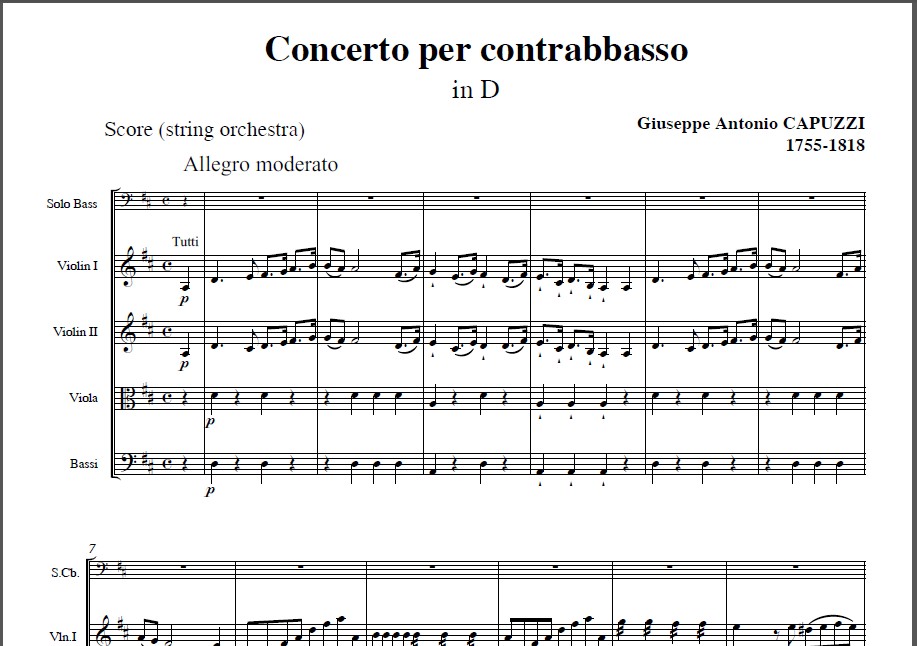GIUSEPPE ANTONIO CAPUZZI | Concerto in D major | DOUBLE BASS AND STRING ORCHESTRA - FULL CONDUCTOR'S SCORE AND ALL PARTS | high-quality edition matching highest professional standards | all parts formatted optimized way for easy page turning
SOURCE: this edition keeps as close as possible to the historical source, an autograph kept in the British Museum under the signature Add. ms. 17834
EXTRAS: this instrumentation is for the string orchestra (full orchestra material for strings and winds can be hired from Yorke Edition). Not less than five double bass solo parts for four different scordaturas are enclosed here | the second movement has two versions: in A major (original key) and in G major
FILE FORMAT: PDF | 300 dpi - extremely high quality | 102 pages
SCORES: Full conductor's score and single parts: 4x solo double bass, violini I, violini II, viola, bassi
SCORDATURA of the double bass: 2x in C (GDAE "orchestra tuning") one part contains second movement transposed into G major for easier playability, 1x transp. in D (AEBF# or "solo tuning"), 1x transp. in F (cGDA) and 1x transp. in G (dAEB)
COMMENT: This edition differs in several aspects from the historical source:
- Unlike the original score, this is the instrumentation for the string orchestra (the original instrumentation includes 2 oboas and 2 horns)
- The score and the parts contain some extra dynamics, articulations and bowings, which should save some rehearsing time. When I used the orchestral material of the Yorke Edition (as in the video), which is almost identical to the original, the orchestral parts sounded largely undefined and unconvincing due to the lack of dynamics and articulations. The additional supplements I have made should save several hours of work.
- composer Capuzzi occasionally used the winds in the accompaniment during the solo passages, which was unusual at the time. These parts from the score are performed by the high strings in this edition
- In the Urtext autograph the cadenza tutti is missing, possibly because the soloist (Marcantonio Montenigo, to whom the concerto was dedicated) decided not to play a cadenza. Since a cadenza would fit stylistically, at least at the end of the first movement, I made a typical cadenza tutti to the first movement from the original material, but as bonus material
- From the perspective of historical playing practice, it is absolutely unclear whether the solo double-bass voice should have been played during the solo passages at the original level, or one octave lower, as no reliable documentation has been handed down. Both are theoretically conceivable, since the solo part - if played one octave lower - never lower than the lowest tone of the then often used 3-string instrument, but also not higher than the E in the small octave goes out, which is absolutely unusual for deep would be a soloist work. There is no other concert for double bass and orchestra from the 18th century where the soloist plays only to a low e as the highest note. If the solo part was to be played from the "Solo" mark at the original level, the work would have been composed in the then commonly used register. From today's perspective and from the perspective of the auditory habits of the audience today (and also from my own point of view), there is no doubt here: the soloist should perform his voice in the higher octave. So the work sounds much more convincing and even so the solo part is not particularly high, since the highest notes are at E1
- Original key of the second movement is A major. It causes however very complicated playability on the modern double bass tuned in Fourths, if the soloist decides to use a common scordatura "orchestra tuning" (GDAE), or its higher variant
- with a high C string. I decided therefore to transpose the second movement also into a subdominant (into G major
- instead of A major), which would stylistically also be one of the commonly used keys for the second movement

*140 EUR | Buy now:
*only for the EU- and UK-residents: the customers will be charged additionally with a VAT on e-services during the checkout process. After the confirmation of the country of customer's residence, the VAT in your respective country's VAT-rate will automatically be added. PDF music is also affected by this rule, which is applied since 2015.


